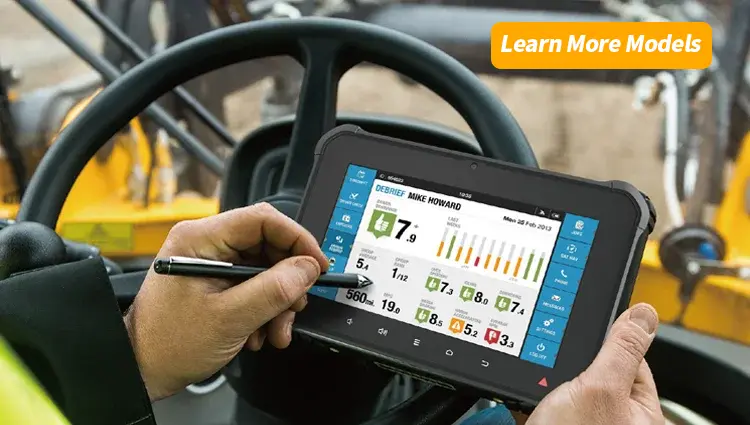Boost Fleet Efficiency Instantly: 7 Proven Ways Tablets Transform Operations
Introduction
In today’s fast-paced logistics and transportation landscape, fleet managers are constantly seeking smarter, faster, and more efficient ways to streamline operations. Paper logs and outdated systems are no longer sufficient. The answer? Rugged tablets and mobile data terminals designed specifically for fleet environments. These digital tools aren’t just convenient—they’re transformative.
But how exactly can tablets optimize fleet operations? Whether you’re managing trucks, buses, taxis, or specialized vehicles, this guide will explore how tablets can revolutionize your workflow, improve driver safety, and reduce operational costs—all while staying connected in real-time.

Why Tablets Are Game-Changers for Fleet Operations
1. Real-Time GPS Tracking & Navigation
One of the most immediate benefits of integrating tablets into fleet operations is real-time GPS tracking. This not only provides accurate driver locations but also allows fleet managers to:
- Monitor routes and identify inefficiencies
- Provide turn-by-turn directions and traffic updates
- Ensure compliance with designated travel paths
🔍 Statistic: Businesses that implement GPS tracking see a 30% improvement in vehicle utilization and a 23% reduction in fuel costs.
2. Seamless Communication Between Drivers and Dispatchers
Traditional two-way radios are unreliable and outdated. Tablets offer instant messaging, video calls, and push-to-talk (PTT) functionality, enhancing communication and decision-making. This leads to:
- Faster response to delivery or pickup changes
- Fewer misunderstandings
- Increased driver accountability
3. Digital Documentation and E-Logs
Manual paperwork slows down processes and is prone to errors. Tablets streamline documentation by offering:
- Digital signature capture
- Automated driver logs and compliance reports
- Electronic Proof of Delivery (ePOD)
These features not only improve accuracy but also help ensure regulatory compliance, such as with ELD mandates.
4. Vehicle Diagnostics and Maintenance Alerts
Tablets equipped with OBD-II or CAN-bus connectivity allow real-time monitoring of:
- Engine performance
- Fuel consumption
- Brake wear and other diagnostic data
Fleet managers can schedule preventive maintenance based on real data, reducing downtime and increasing vehicle lifespan by up to 20%.

5. Driver Behavior Monitoring
Tablets can be paired with telematics solutions to track driver behavior, including:
- Harsh braking
- Speeding
- Idling time
By promoting safer driving habits, companies can lower accident rates and reduce insurance premiums.
📊 Insight: Companies using driver behavior monitoring saw a 40% decrease in accidents and a 15% reduction in fuel usage.
6. Paperless Route Planning and Load Management
With integrated logistics apps, tablets can optimize:
- Load assignments
- Route sequencing
- Delivery schedules
This minimizes wasted mileage and maximizes delivery efficiency. Plus, drivers can update job status with a single tap, offering full transparency across the fleet.
7. Secure Data Handling & Remote Management
Advanced tablets come with built-in security features like:
- Device encryption
- Biometric access
- Remote device management and locking
This ensures sensitive data is protected, especially when tablets are used in-field or in shared environments.

Frequently Asked Questions (FAQs)
Q1: What kind of tablet is best for fleet management?
A: Rugged Android or Windows tablets with long battery life, 4G/LTE, GPS, and durable build are ideal. Devices like the Waysion Q777 offer vehicle-mount options and integrated communication modules for optimal performance.
Q2: Is it expensive to implement tablets across a fleet?
A: While there is an upfront investment, companies typically see ROI within 6–12 months through savings in fuel, time, paperwork, and vehicle maintenance.
Q3: Can tablets help with compliance and audits?
A: Absolutely. Tablets store digital logs, inspection reports, and proof of delivery, making audits faster and ensuring legal compliance with industry regulations like HOS and FMCSA standards.
Q4: How are tablets installed in vehicles?
A: Tablets can be dash-mounted with rugged brackets or used in handheld mode. Many support vehicle docking stations with charging and connectivity features.
Q5: What apps should be installed on a fleet tablet?
A: Key apps include:
- Fleet management software (e.g., Samsara, Geotab)
- Navigation (Google Maps, Waze)
- ELD apps (KeepTruckin, BigRoad)
- Communication tools (Microsoft Teams, Zello)
Conclusion
Tablets are no longer a luxury in fleet operations—they’re a necessity. With features like GPS tracking, digital documentation, driver monitoring, and predictive maintenance, tablets provide everything fleet managers need to cut costs, improve safety, and boost productivity.
If you’re ready to transform your fleet, start with a rugged tablet built for the road. The longer you wait, the more time, fuel, and money you’re leaving on the table.








